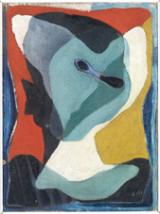Figueres, 21st January 2008
The Gala-Salvador Dalí Foundation has presented a previously unshown oil painting that now goes to form part of the exhibition on Salvador Dalí’s self-portraits being held at the Theatre-Museum and that will now be extended until the end of the summer 2008 season. The work is called Untitled. Self-Portrait Splitting into Three or Harlequin, ca 1926, and comes from a private collection (see the on-line Catalogue Raisonné, no. 1015).
The ceremony took place under the dome and was presided over by Antoni Pitxot, Director of the Dalí Theatre-Museum and Vice-Chairman of the Foundation, and Montse Aguer, Director of the Centre for Dalinian Studies, both trustees of the institution.
On 8 October 2007 the Dalí Foundation presented an exhibition devoted to the theme of the self-portrait in Salvador Dalí’s oeuvre. The initiative arose out of a temporary loan of three works from the Salvador Dalí Museum in Saint Petersburg (Florida, USA). As a result of that loan, and thanks to the works-exchange policy that had started the previous year between museums and private collections, we can today show a previously unseen work by the painter.
In creating this painting, Dalí used the rear side of a landscape canvas he had painted earlier, Untitled. Landscape with Olive Trees, ca 1923 (Catalogue Raisonné no. 1016) painted, as was usual during this period, directly onto the canvas. In it, we see a split face, painted using intense colours.
This unfurled or split image, with which he represents himself, is open to various interpretations. Some authors uphold that Federico García Lorca is present in the production of Dalí’s work, and specifically in some canvases from the years 1926-27, coinciding with the time at which the two men were most closely attuned with one other.
Other authors feel, rather, that it is Pablo Picasso’s influence that is decisive in the works that Dalí created in 1926. Dalí visited the Malaga painter in the April of that year on a trip that he made to Paris accompanied by his sister and his aunt. Picasso, for whom Dalí felt great admiration, received him and showed him his latest works, which he would soon be hanging at the gallery of his dealer, Paul Rosenberg. Viewing those canvases made a deep impression on Dalí, and in the works he created from then on we find significant references to and analogies with Picasso’s works dating from that year.
Thus, Self-Portrait Splitting into Three or Harlequin, ca 1926, shows features in common with other works, such as: Still Life by Moonlight,, 1926 (Catalogue Raisonné no. 196); Still Life by Mauve Moonlight, 1926 (Catalogue Raisonné no. 186); Barcelona Mannequin, 1926 (Catalogue Raisonné no. 169); Two Figures, 1926 (Catalogue Raisonné no. 184); Still Life. “Invitation to Dream”, 1926 (Catalogue Raisonné no. 172); Table in front of the Sea. Homage to Eric Satie, 1926 (Catalogue Raisonné no. 187); Head, 1926 (Catalogue Raisonné no. 192); Watermelon and Mandolin, 1926 (Catalogue Raisonné no. 170); Self-Portrait Splitting into Three, 1926-27 (Catalogue Raisonné no. 191) and Harlequin, 1926 (Catalogue Raisonné no. 193). We find in these works similar iconographic motifs: split faces, eyes that become a single eye, severed heads that glide above a black shadow, some of them inspired in the works that Dalí saw at Picasso’s studio, and present also in Self-Portrait Splitting into Three.
The work Untitled. Self-Portrait Splitting into Three or Harlequin, ca 1926, undoubtedly enriches the exhibition that can be visited in the Dalí d'Or Room (antecrypt) at the Dalí Theatre-Museum, devoted to the self portraits and set to run until the end of summer 2008.






